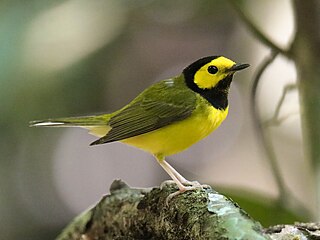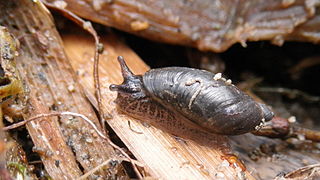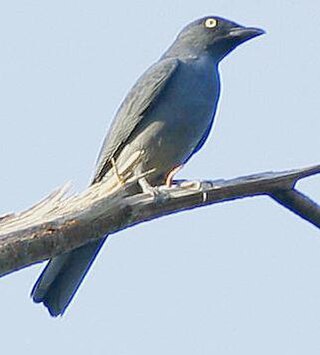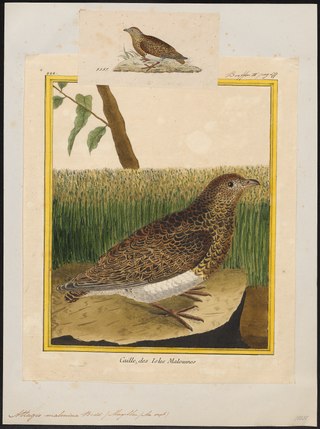
Sunnyodon is a genus of tiny, extinct mammal, probably of the Lower Cretaceous. Found in what is now southern England and Denmark, it was a relatively early member of the extinct order of Multituberculata. It is part of the suborder Plagiaulacida and family Paulchoffatiidae.

The hooded warbler is a New World warbler. It breeds in eastern North America across the eastern United States and into southernmost Canada (Ontario). It is migratory, wintering in Central America and the West Indies. Hooded warblers are very rare vagrants to western Europe.

The Kangaroo Island emu or dwarf emu is an extinct subspecies of emu. It was restricted to Kangaroo Island, South Australia, which was known as Ile Decrés by the members of the Baudin expedition. It differed from the mainland emu mainly in its smaller size. The species became extinct by about 1827.
Nepenthes masoalensis is one of two tropical pitcher plant species from Madagascar, the other being N. madagascariensis.

Pousargues's mongoose, also known as the African tropical savannah mongoose, is a mongoose native to Central Africa. It is listed as data deficient on the IUCN Red List as little is known about its distribution and ecology. It is the only species in the genus Dologale.

Oxyloma elegans is a species of small European land snail, a terrestrial pulmonate gastropod mollusk belonging to the family Succineidae, the amber snails.

The lilac-tailed parrotlet is a species of bird in subfamily Arinae of the family Psittacidae, the African and New World parrots. It is found in Colombia, French Guiana, Guyana, Suriname, Trinidad, and Venezuela.

The yellow-breasted crake is a species of bird in subfamily Rallinae of family Rallidae, the rails, gallinules, and coots. It is found on several Caribbean islands and in most of Central America and South America.

The bar-bellied cuckooshrike is a species of bird in the family Campephagidae. It is found in Thailand, Malaysia, Indonesia, and the Philippines, and its natural habitats include mangrove forest, dry forest, swamp forest, and secondary forest. The plumage varies among the subspecies, with different amounts of barring on the underparts. The International Union for Conservation of Nature (IUCN) has assessed the species as one of least-concern.

The white-bellied seedsnipe is a species of bird in suborder Scolopaci of order Charadriiformes, the shorebirds. It is found Argentina and Chile.
Haplochromis perrieri is a species of cichlid endemic to Lake Victoria though it may now be extinct in the wild. These fish are part of the Lake Victoria Species Survival Program, and captive populations exist within the public aquarium community. This species can reach a length of 6 centimetres (2.4 in) SL. This species' specific name honours the French zoologist Edmond Perrier (1844-1921) who was the director of Muséum National d’Histoire Naturelle from 1900–1919.

Parmacella is a genus of air-breathing land slugs, terrestrial gastropod mollusks in the family Parmacellidae.
Paramacellodus is an extinct genus of scincomorph lizards from the Early Cretaceous of England and France, and the Late Jurassic of Portugal and the western United States. The type species, Paramacellodus oweni, was named in 1967 from the earliest Cretaceous (Berriasian) Purbeck Group in Dorset, England. Additional material referable to a species of Paramacellodus, possibly P. oweni, has been described from the Morrison Formation, specifically in Como Bluff, Wyoming, and Dinosaur National Monument, Utah. An indeterminate species is known from the Berriasian aged Angeac-Charente bonebed in France. Paramacellodus belongs to an extinct family of scincomorphs called Paramacellodidae, which spanned most of Laurasia during the Late Jurassic and Early Cretaceous and represented one of the earliest evolutionary radiations of lizards.

Theodore Wells Pietsch III is an American systematist and evolutionary biologist especially known for his studies of anglerfishes. Pietsch has described 72 species and 14 genera of fishes and published numerous scientific papers focusing on the relationships, evolutionary history, and functional morphology of teleosts, particularly deep-sea taxa. For this body of work, Pietsch was awarded the Robert H. Gibbs Jr. Memorial Award in Systematic Ichthyology by the American Society of Ichthyologists and Herpetologists in 2005. Pietsch has spent most of his career at the University of Washington in Seattle as a professor mentoring graduate students, teaching ichthyology to undergraduates, and curating the ichthyology collections of the UW Burke Museum of Natural History and Culture.

Palinurus charlestoni is a species of spiny lobster which is endemic to the waters of Cape Verde. It grows to a total length of 50 cm (20 in) and can be distinguished from other Atlantic species in the genus by the pattern of horizontal bands on its legs. It was discovered by French fishermen in 1963, and has been the subject of small-scale fishery since. It is thought to be overexploited, and is listed as Near Threatened on the IUCN Red List.

Brookesia decaryi is a species of chameleon, which is endemic to Madagascar, and is ranked as an endangered species by the International Union for Conservation of Nature (IUCN). It was initially described in 1939 by Fernand Angel. B. decaryi is commonly known as Decary's leaf chameleon, spiny leaf chameleon, or Decary's pygmy chameleon.

Croizetoceros is an extinct genus of deer which lived throughout much of Europe, first appearing during the last stages of the Miocene and living until the Early Pleistocene.

Jean-Lou Justine, French parasitologist and zoologist, is a professor at the National Museum of Natural History in Paris, France, and a specialist of fish parasites and invasive land planarians.
Flexiseps ardouini, also known commonly as the yellow skink, is a species of lizard in the family Scincidae. The species is endemic to Madagascar.














